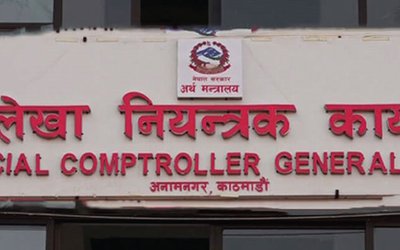The International Monetary Fund (IMF) views the current situation of Nepal in an interesting light. A report titled ‘Nepal: Recent Fiscal Developments’ shows that Nepal’s public debt is on a downward trend over the past decade. The report compared this downward trend to the trend of other ‘low-income countries’ (LIC) – the median of public debt of other 45 LICs has seen a sharp increase since 2012. However, Nepal’s debt has seen a sharp decline since 2006. The IMF has attributed this decline to the fact that, especially in the last three months, Nepal has had low capital spending despite revenue growth.
Let us talk about why the IMF has put an ‘interesting spin’ in the report on Nepal’s public debt. The report makes us question whether decrease in public debt is actually beneficial or not-so-beneficial for the country. Less public debt reveals that the budget is in a surplus state and that the country is not taking out more loans to cover up a budget deficit – this seems to be beneficial for Nepal’s economy. However, the IMF report links the decrease in public debt to low capital spending, in that Nepal has not been able to spend all the money raised through significant channels and invested in sources that will lead to a long term revenue growth. Capital expenditure of the review period stood only at 6.5 percent of annual budget estimate of 208.88 billion – this appears to be harmful for Nepal’s economy. Low capital spending reveals lack of dynamic economic activities and also reveals that the earthquake and the crisis that followed stalled many key capital expenditures of the country. The 52 billion that was unspent from fiscal year 2013/14 was carried over to fiscal year 2014/2015. Likewise, 48 billion that was unspent from fiscal year 2014/2015 has been carried over to the fiscal budget of 2015/2016.
How should Nepal move forward then? It cannot be contested that Nepal should be utilizing all the money raised and investing in development and long term sustainable projects. Most of our public debt resources comprises loans taken from development partners and they should be duly utilized. However, it is also necessary to note that we should be careful in utilizing the public debt and spending in these ‘capital expenditures.’ We should be wary about the fact that if the country does not appropriately monitor its spending on capital expenditures, it is very easy for the country to over spend, incur deficit, and borrow more without actually having the capacity to repay the loans.
IMF has flagged the issue that Nepal is ranked low in its capital spending; however, has IMF flagged the possibility and danger of overspending and over-borrowing by ‘low-income countries’ such as Nepal? The likelihood of IMF actually warning countries against the danger of over-borrowing is quite low. Why, one might ask. It becomes necessary to understand how IMF works and what kind of leverage it exerts over the so-called ‘low-income countries.’ Originally established to provide countries with short term loans to help them achieve balance of payments, the IMF, since the 1980s, has been providing emergency loan packages to countries and these packages come with certain policies, called the structural adjustment policies (SAPs). These policies are economic policies designed for ‘developing countries’ by international organizations such as the World Bank and the IMF. The developing countries or countries who are undergoing financial crisis are provided loans by the IMF on the condition that they adopt economic policies prescribed by the IMF. For example, for countries to be able to borrow from IMF, it has to agree on IMF’s policies regarding how much the borrower countries can spend on health care, development projects, education, protection, environment, and so on.
It is a myth that these structural adjustment policies, ‘prescribed for the economic development of low-income countries’, are always beneficial for borrower countries. One cannot ignore the fact that that decision making capacity of rich and powerful member countries gets more leverage in designing the SAPs. This increases the likelihood of the gap between the ‘first world’ countries and the ‘third world’ countries to widen even more. Countries’ lose their capacity to develop policies that are strong and suit the country’s needs. For example, Bishnu Rimal in an article states that, in the 1990s, the Nepali government emphasized privatization of industries based on the recommendations by IMF. Public enterprises were sold to capitalists and foreign companies despite the fact that most of these companies were operating in profits. This, among other such policies, did not help the country’s economy.
Nepal thus needs to be cautious regarding how it utilizes the money raised and how can it repay its loans from the sources it invests in. It is not easy to escape the gaze of organizations such as the IMF; however, it is inevitable that the country plans its future moves carefully.
- Poor (country) on a pile of money
- Dec 16, 2016
- Careful Financial Regrouping Cutbacks Imminent
- Nov 18, 2016
- Women Securing Water
- Oct 01, 2016
- Faithful or Fearful Fluctuations
- Aug 31, 2016
- Walking on Prachanda path?
- Aug 11, 2016

















